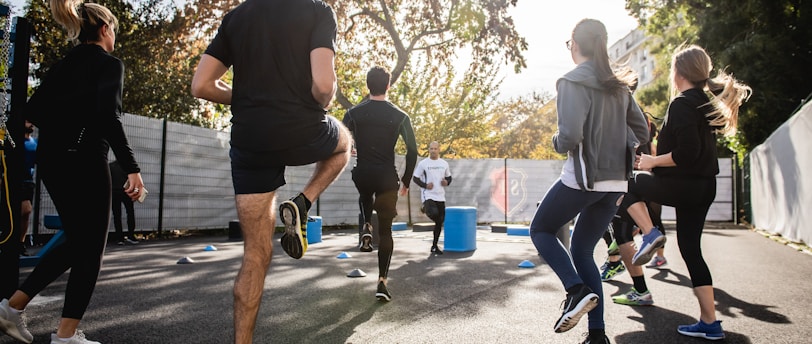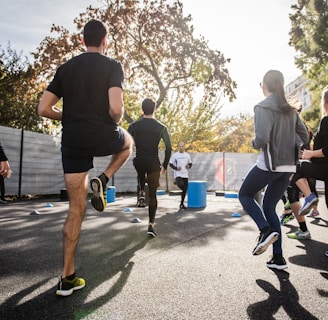
Effective Workout Tips for Weight Loss: Your Ultimate Guide Today
WEIGHT LOSSTRAININGS
11/27/20246 min read



Ratings: 5 stars! ★★★★★
Introduction: The Importance of Exercise in Weight Loss
Exercise is a fundamental component of any successful weight loss strategy, serving both to promote calorie burning and stimulate metabolic function. When individuals engage in physical activity, their bodies require energy, which is sourced from stored fat and carbohydrates. This process not only assists in burning excess calories but also plays a pivotal role in achieving a caloric deficit—an essential principle for weight loss. Regular engagement in exercise helps to elevate metabolic rate, leading to increased energy consumption even at rest.
The synergy between exercise and a balanced diet cannot be overstated. While nutrition plays a crucial role in managing weight, incorporating physical activity amplifies its effectiveness significantly. Studies indicate that individuals who combine both a healthy diet and a consistent exercise regimen tend to lose weight more effectively than those who rely on dietary changes alone. Furthermore, even moderate exercise can yield substantial benefits, debunking the myth that high-intensity workouts are the only effective means to achieve weight loss goals.
Moderate exercises, such as brisk walking, cycling, or swimming, can be particularly beneficial for beginners or individuals with certain limitations. These activities help to build endurance, strength, and flexibility, which contribute to overall physical health. Importantly, such exercises not only aid in shedding pounds but also improve cardiovascular health, reduce stress levels, and enhance mood, making the weight loss journey more sustainable over time.
This introduction lays the groundwork for understanding the types of workouts and actionable tips that will follow in this comprehensive guide. By recognizing the importance of exercise in weight loss, individuals can better prepare themselves to adopt an active lifestyle that supports their weight management goals.
Workout Types: Cardio, Strength Training, and HIIT
When it comes to effective weight loss, incorporating a variety of workout types is crucial for achieving optimal results. The three primary categories of workouts that can significantly aid in weight loss are cardiovascular exercises, strength training, and high-intensity interval training (HIIT). Each of these workout types offers unique benefits and can be tailored to fit individual fitness levels and preferences.
Cardio workouts, such as running, cycling, and swimming, are essential for burning calories and improving cardiovascular health. They engage large muscle groups and elevate the heart rate, promoting fat loss. For effective weight loss, it is generally recommended to engage in at least 150 minutes of moderate-intensity cardio per week. This duration can be split into manageable sessions, such as 30 minutes a day, five times a week. Incorporating variety into cardio routines, such as interval training or fitness classes, can keep workouts engaging and stimulating.
Strength training, on the other hand, focuses on building muscle mass, which is essential for maintaining metabolic functions. Engaging in strength training exercises, such as weight lifting, resistance band workouts, or bodyweight exercises, not only aids in fat loss but also enhances tone and definition. Experts recommend performing strength training exercises at least two to three times per week, targeting all major muscle groups. Compound movements, like squats and deadlifts, are particularly effective as they engage multiple muscles simultaneously.
High-intensity interval training (HIIT) combines short bursts of intense activity with periods of rest or low-intensity exercise. This workout type is particularly efficient for burning calories in a shorter time frame, making it ideal for those with a busy schedule. A typical HIIT session can last from 20 to 30 minutes, offering maximum results in minimal time. Exercises like burpees, jump squats, and high knees can be incorporated into HIIT circuits.
Incorporating these three workout types into your fitness regimen allows for a well-rounded approach to weight loss, catering to different fitness goals and preferences. Understanding the benefits of cardio, strength training, and HIIT will empower individuals to create an effective and sustainable workout plan tailored to their personal goals.
Creating a Personalized Workout Plan
Developing a personalized workout plan is an essential step toward achieving weight loss goals effectively. The first step in this process is setting clear, attainable fitness goals. These goals should consider your current fitness levels, any existing health conditions, and your long-term objectives. It is advisable to use the SMART criteria, ensuring that your goals are Specific, Measurable, Achievable, Relevant, and Time-bound. For instance, rather than setting a general goal like "I want to lose weight," specify that you aim to lose 5 pounds in a month through consistent workouts and dietary changes.
Next, consider how often you can realistically commit to exercising each week. For most individuals, incorporating a mix of cardio, strength training, and flexibility exercises can provide comprehensive benefits. A commonly suggested frequency is three to five days of workouts per week, with at least one day dedicated to each type of exercise. This approach helps in maintaining a balanced routine that promotes overall fitness while assisting in weight loss. When curating your weekly workout sessions, think about your lifestyle and daily obligations; ensuring your plan is manageable increases the likelihood of adherence.
Rest days are just as important as workout days. Incorporating them into your personalized workout plan allows your muscles to recover, minimizing the risk of injury and ensuring sustained progress. Allocate at least one or two rest days throughout the week, depending on the intensity of your workouts. Additionally, as you advance in your fitness journey, it is crucial to adapt your workout plan, increasing intensity or adjusting routines to continue challenging your body. This adaptability not only helps maintain motivation levels but also fosters continuous improvement in your weight loss efforts.
Daily Activity and Nutrition: Elevating Your Weight Loss Journey
Incorporating daily activity into your routine is crucial to achieving effective weight loss. Activities such as walking, climbing stairs, or engaging in active hobbies can significantly boost calorie expenditure beyond structured workout sessions. For instance, opting to take the stairs instead of the elevator provides a simple yet impactful method to incorporate physical activity into your day. Walking, whether during breaks at work or for errands, is another excellent way to stay active. Setting a goal, such as taking a brisk walk for at least 30 minutes daily, promotes sustained movement and engages multiple muscle groups. Additionally, active hobbies like dancing, gardening, or playing sports can contribute positively to your overall physical activity levels while also bringing enjoyment to your weight loss journey.
Nourishing your body through balanced nutrition is equally important. A well-rounded diet supports your fitness efforts and helps sustain your energy levels throughout the day. Incorporate a variety of fruits, vegetables, whole grains, and lean proteins into your meals to ensure proper nutrient intake. These foods provide essential vitamins and minerals while being low in unhealthy fats and sugars, which can help manage weight. Furthermore, portion control is vital; using smaller plates or measuring servings can prevent overeating, thus aiding in weight management.
Staying hydrated is another key factor in supporting weight loss. Drinking adequate water throughout the day helps improve metabolism and maintain proper body function. It is often recommended to aim for at least eight 8-ounce glasses of water daily, but individual needs may vary based on activity levels and climate. Additionally, choosing water over sugary drinks can significantly cut down calorie consumption, facilitating more effective weight loss. By focusing on enhanced daily activities and proper nutrition, individuals can create a sustainable environment for their weight loss efforts.
Staying Motivated
Maintaining motivation throughout the weight loss journey can be challenging, but implementing effective strategies can make a significant difference. One of the most impactful methods is to track progress regularly. Keeping a journal, using an app, or even taking weekly photos can help individuals visualize their achievements, no matter how small. Celebrating these milestones can provide a sense of accomplishment that fuels further progress. Additionally, regularly assessing fitness measurements and tracking dietary intake can create a clearer understanding of which aspects are yielding positive results and which may require modifications.
Another effective way to stay motivated is by setting new challenges for oneself. After reaching initial goals, consider setting intermediate milestones, such as increasing workout intensity, trying new exercises, or training for a specific event. These challenges not only keep the routine fresh and engaging but also push individuals out of their comfort zone, fostering continuous personal growth. It is also beneficial to establish both short-term and long-term goals, allowing individuals to enjoy the journey and appreciate every step along the way.
Furthermore, seeking support from communities or workout partners can play a crucial role in sustaining motivation. Engaging with like-minded individuals allows for shared experiences, tips, and encouragement, making the process feel less isolating. This support system can include workout classes, online forums, or local groups focused on fitness and weight loss. Having an accountability partner can increase personal commitment and make workouts more enjoyable, ultimately leading to better results.
Conclusion
In summary, staying motivated during a weight loss journey is integral to achieving long-term success. By tracking progress, setting new challenges, and seeking support from others, individuals can cultivate an environment conducive to weight loss and overall well-being. Remember, the path to achieving weight loss goals requires consistent effort and commitment.
Taking that first step today can lead to significant changes tomorrow, helping you reach not only your fitness aspirations but overall health objectives as well.

